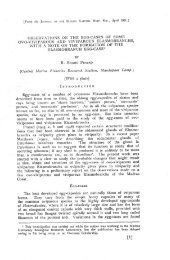PDF - Eprints@CMFRI
PDF - Eprints@CMFRI
PDF - Eprints@CMFRI
You also want an ePaper? Increase the reach of your titles
YUMPU automatically turns print PDFs into web optimized ePapers that Google loves.
158<br />
Heterocyatbus aequicostatus MILNE EDWARDS and HAIME, 1848<br />
HereTocyatbus aequicostotus<br />
beterocostatus<br />
oblongatus<br />
parasiticu!<br />
phi/ippinensis<br />
pulcbelJus<br />
UJood-masoni<br />
(Plate 36, Fig. 9)<br />
1848, MILNE EDWARDS & HAIME. 324 ; pI. 10/ 8 (Type locality : unknown),<br />
1904 •. GARDINER. lOS: pI. )/1 - 43 (synonymy).<br />
1905 , BOURNE. 193 and 213: figs. 2. 3: pis. 3/ 12- 18: 4/19-21.<br />
1906. v. MAR ENZELLER. 90.<br />
1909. HARRISON & POOLE. 898. pI. 8S / la- f.<br />
1927. FAUSTINO. 83: pI. 8/ 1-7.<br />
1974. SCHEER & PI LLAI. 6 I; pI. 28/ 3. 4 (synonymy).<br />
1938. GARDINER & WAUGH. 187.<br />
1892. REHBERG. 9: pI. 21 1. 2.<br />
1872, SEMPER. 255 ; pl. 20/ 17a- c.<br />
1872, SEMPER. 254 ; pI. 20/ 12- 14.<br />
1892, REHBERG, 8; pI. I l7a, b.<br />
1893, ALCOCK, 141 ; pI. 5/4, 4a.<br />
Solitary, enclosing a gastropod shell. Basal part laterally with some small openings of the commensal<br />
sipunculid (for details see FEUSTEL, 1966). Height up to 10 mm. Diameter of the calyx up to 12 mm.<br />
Calices circular or oval, shallow (J to 2 mm). Septa in five cycles. Primaries and secondaries subequal, or<br />
t he primaries may be more thickened and forming a six-rayed srar. All septa exsert, primaries the maximum.<br />
Edges of larger septa entire, those of higher cycles serrated. Three cycles of septa reach the columella,<br />
others unite with the lower cycles. Pali present before the first four cycles of septa, those of the primaries<br />
are the largest and bi- or trilobed. Costae correspond to septa, those of the primary and secondary septa<br />
prominent. Edges of costae granular.<br />
The present samples are all small (2 to 9 mm in diameter), some are only attached to gastropods and<br />
the latter are not enclosed at the base of the coral. The same is reported by GARDINER & WAUGH (1938)<br />
of their H beterocostatus from southern Red Sea (depth 375 m, Stat. 207), which we consider as synonymous<br />
with H aequicostatus.<br />
Mat e rial :<br />
Gulf of Aqaba: T. Aviv NS 13 55 , 5409 , 5415 , 5423 (Eilat), (each o. comprehends several<br />
specimens).<br />
Dis t rib uti 0 n : Red Sea; East Africa; Persian Gulf; Maldives ; Gulf of Mannar along the Indian<br />
coast ; Ceylon; Andamans; Nicobars ; Mergui Archipelago; China Sea; Philippines; Japan; Eastern Pacific.<br />
Rem ark s : The type of H wood-masoni ALCOCK is No. 5958/9 in the Indian Museum Calcutta.<br />
The distinguishing feature of this is the prominence of the primary septa, forming a six-rayed star. SCHEER<br />
& PILLAI (1974) had many specimens from the Nicobars (near the type locality of H wood-masoni), in<br />
some of them this feature is very conspicuous (see pI. 28, fig. 3 of SCHEER & PILLAI). We feel that this<br />
is only a skeletal variation, and H wood-masoni has no separate status.<br />
Subfamily Oesmophyllinae VAUGHAN and WELLS, 1943<br />
Genus Dactylotrocbus WELLS, 1954<br />
T Y pes pee i e s : Tridacopbyllia cervicornis MOSELEY , 1881.<br />
G e n e ric c h a rae t e r s : Solitary. Columella absent. Wall with two or more fingerlike prolongations.<br />
Dactylotrocbus cervicornis (MOSELEY), 1881<br />
(Fig. 3; PI. 40. Fig. 4, centre=)<br />
Tridacopbyllill cervicornis 1881 , MOSELEY, 183 ; pI. 10/ 2, 2a- c, 3, h (Type! locality unknown).<br />
Dactylotrocbus ceruicornis 1954 , WELLS, 470; pI. 178/ 1-3.<br />
Tridacopbyllia primordialis 1899, GARDINER. 168 ; pI. 19/7.
















